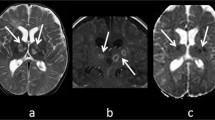Abstract
The case records of 49 patients discharged from St George’s Hospital, London, between December 2000 and March 2004 with the diagnosis of brain abscess were reviewed in order to document the epidemiology, causes, treatment, and prognostic factors associated with brain abscess. Brain abscess occurred at all ages, more frequently in men than in women. Headache and altered mental status were common presenting symptoms. The frontal lobe was the most common site. Streptococcal infection was seen most commonly, but staphylococcal infection predominated in cases following neurosurgery. Computed tomography provided sufficient diagnostic information in most cases. All but five patients had early surgical drainage. Cefotaxime and metronidazole were used most often for empirical therapy. Thirty-nine patients recovered fully or had minimal incapacity. Five patients died. Patients with underlying cranial neoplasms or medical conditions had a worse outcome than those with a contiguous focus of infection or post-traumatic abscess. Changes in disease pattern were determined by comparison to a literature review. A PubMed search of the literature using the keywords “brain abscess” was undertaken, and identified papers and relevant citations were reviewed. Compared to earlier series, there was a marked decrease in the number of cases of brain abscess secondary to otitis media and congenital heart disease. There was an increase in the number of cases of brain abscess secondary to neurosurgery and trauma. Changes in the epidemiology of predisposing conditions for brain abscess are associated with changes in the patient population and causative organisms. Though still a potentially fatal infection, there have been recent improvements in diagnosis, treatment, and outcome.



Similar content being viewed by others
References
Mathisen GE, Johnson JP (1997) Brain abscess. Clin Infect Dis 25:763–781
Kao P-T, Tseng H-S, Liu C-P, Su S-C, Lee C-M (2003) Brain abscess: clinical analysis of 53 cases. J Microbiol Immunol Infect 36:129–136
Roche M, Humphreys H, Smythe E, Phillips J, Cunney R, McNamara E, O’Brien D, McArdle O (2003) A twelve-year review of central nervous system bacterial abscesses: presentation and aetiology. Clin Microbiol Infect 9:803–809
Lu C-H, Chang W-U, Lin Y-C, Tsai N-W, Liliang P-C, Su T-M, Rau C-S, Tsai Y-D, Liang C-L, Chang C-J, Lee P-Y, Chang H-W, Wu J-J (2002) Bacterial brain abscess: microbial features, epidemiological trends and therapeutic outcomes. Q J Med 95:501–509
Seydoux Ch, Francioli P (1992) Bacterial brain abscesses: factors influencing mortality and sequelae. Clin Infect Dis 15:394–401
Mamelak AN, Mampalam T, Obana WG, Rosenblum ML (1995) Improved management of multiple brain abscesses: a combined surgical and medical approach. Neurosurgery 36:76–86
Renton TF, Danks J, Rosenfield JV (1996) Cerebral abscess complicating dental treatment. Case report and review of the literature. Aust Dent J 41:12–15
British Health Protection Agency (2005) Investigation of abscesses and deep seated wound infections. BSOP 14. http://www.hpa-standardmethods.org.uk
Grigoriadis E, Gold W (1997) Pyogenic brain abscess caused by Streptococcus pneumoniae: case report and review. Clin Infect Dis 25:1108–1112
Ratanasiri B (1995) Ten year review of brain abscess in Children’s Hospital Bangkok, Thailand. J Med Assoc Thai 78:37–41
De Louvois J, Gortval P, Hurley R (1977) Bacteriology of abscesses of the central nervous system: a multicentre prospective study. Br Med J 2:981–984
Sennaroglu L, Sozeri B (2000) Otogenic brain abscess: review of 41 cases. Otolaryngol Head Neck Surg 123:751–755
Osma U, Cureoglu S, Hosoglu S (2000) The complications of chronic otitis media: report of 93 cases. J Laryngol Otol 114:97–100
Infection in Neurosurgery Working Party of the British Society for Antimicrobial Chemotherapy (2000) The rational use of antibiotics in the treatment of brain abscess. British J Neurosurg 14:525–530
Rosenblum ML, Hoff JT, Norman D, Weinstein PR, Pitts L (1978) Decreased mortality from brain abscesses since the advent of computerized tomography. J Neurosurg 49:658–668
Miller ES, Dias PS, Uttley D (1988) CT scanning in the management of intracranial abscess: a review of 100 cases. Br J Neurosurg 2:439–446
Patir R, Sood S, Bhatia R (1995) Post-traumatic brain abscess: experience of 36 patients. Br J Neurosurg 9:29–35
Valarezo J, Cohen JE, Valarezo L, Spektor S, Shoshan Y, Rosenthal G, Umansky F (2003) Nocardial cerebral abscess: report of three cases and review of the current neurosurgical management. Neurol Res 25:27–30
Shin JH, Lee HK (2003) Nocardial brain abscess in a renal transplant recipient. Clin Imaging 27:321–324
Malincarne L, Marroni M, Farina C, Camanni G, Valente M, Belfiori B, Fiorucci S, Floridi P, Cardaccia A, Stagni G (2002) Primary brain abscess with Nocardia farcinica in an immunocompetent patient. Clin Neurol Neurosurg 104:132–135
Stapleton SR, Bell BA, Uttley D (1993) Stereotactic aspiration of brain abscesses: is this the treatment of choice? Acta Neurochir (Wien) 121:15–19
Skrap M, Melatini A, Vassallo A, Sidoti C (1996) Stereotactic aspiration and drainage of brain abscesses. Experience with 9 cases. Minim Invas Neurosurg 39:108–112
Boviatis EJ, Kouyialis AT, Strangalis G, Korfas S, Sakas DE (2003) CT-guided stereotactic aspiration of brain abscesses. Neurosurg Rev 23:206–209
Sjolin J, Lilja A, Eriksson N, Arneborn P, Cars O (1993) Treatment of brain abscess with cefotaxime and metronidazole: prospective study on 15 consecutive patients. Clin Infect Dis 17:857–863
Jansson A-K, Enbland P, Sjolin J (2004) Efficacy and safety of cefotaxime in combination with metronidazole for empirical treatment of brain abscess in clinical practice: a retrospective study of 66 consecutive cases. Eur J Clin Microbiol Infect Dis 23:7–14
Author information
Authors and Affiliations
Corresponding author
Rights and permissions
About this article
Cite this article
Carpenter, J., Stapleton, S. & Holliman, R. Retrospective analysis of 49 cases of brain abscess and review of the literature. Eur J Clin Microbiol Infect Dis 26, 1–11 (2007). https://doi.org/10.1007/s10096-006-0236-6
Published:
Issue Date:
DOI: https://doi.org/10.1007/s10096-006-0236-6




